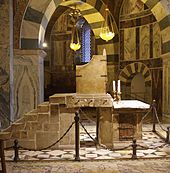Palatine Chapel, Aachen
The Palatine Chapel in Aachen is an early medieval chapel and remaining component of Charlemagne's Palace of Aachen in what is now Germany. Although the palace itself no longer exists, the chapel was preserved and now forms the central part of Aachen Cathedral. It is Aachen's major landmark and a central monument of the Carolingian Renaissance. The chapel held the remains of Charlemagne. Later it was appropriated by the Ottonians and coronations were held there from 936 to 1531.
As part of Aachen Cathedral, the chapel is designated as a UNESCO World Heritage Site.
 Throne of Charlemagne in the palace chapel
Throne of Charlemagne in the palace chapel Sunset view of the Palatine Chapel
Sunset view of the Palatine ChapelCharlemagne began the construction of the Palatine Chapel around 792, along with the building of the rest of the palace structures.[1] It was consecrated in 805 by Pope Leo III in honour of the Virgin Mary. The building is a centrally planned, domed chapel. The east end had a square apse, and was originally flanked by two basilican structures, now lost but known through archaeology. The chapel was entered through a monumental atrium, to the west. The plan and decoration of the building combines elements of Classical, Byzantine and Pre-Romanesque, and opulent materials as the expression of a new royal house, ruled by Charlemagne.
The architect responsible, Odo of Metz, is named in a tenth-century inscription around the dome: Insignem hanc dignitatis aulam Karolus caesar magnus instituit; egregius Odo magister explevit, Metensi fotus in urbe quiescit. Nothing more is known of him. The building he designed has a simple exterior and a complex interior, with a double shell octagonal dome resting on heavy piers, a two-story elevation, and elaborate revetment[2] and decoration.
In 936 Otto I, the first Holy Roman Emperor of the Ottonian dynasty, took advantage of the chapel's close association with Charlemagne and held his coronation as King of Germany there. Holy Roman Emperors continued to be crowned in the Palatine Chapel until 1531.[3] In 1000, in what was most likely a symbolic exhibition, Otto III placed the tomb of Charlemagne in the chapel and paid homage to his remains.[4] The original tomb was probably a sepulchral niche, afterwards known as the "Karlsmemorie", but destroyed in 1788.[5]






























Add new comment